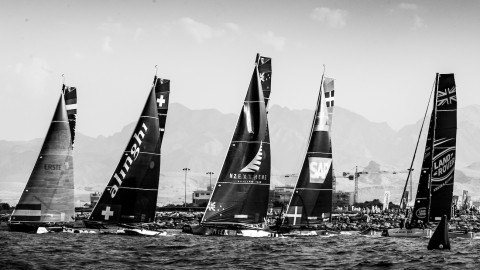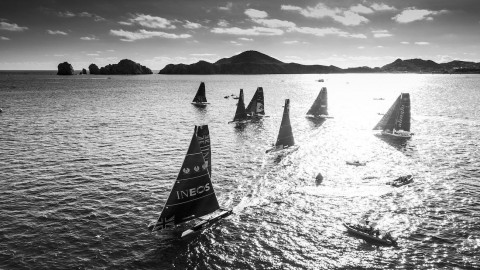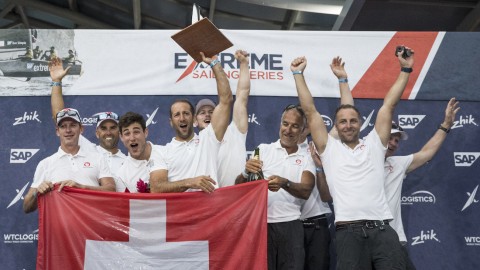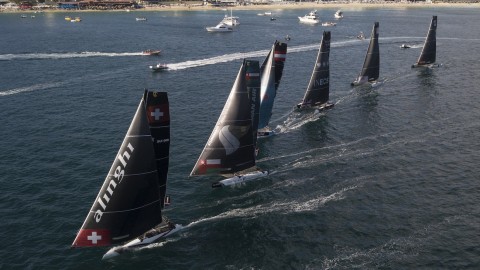Filming at the Extreme edge
Sailing an Extreme 40 is hard enough. Imagine what it is like for the cameramen who go on board these high performance catamarans.
Thursday 2nd July 2015

Sailing an Extreme 40 is hard enough. Imagine what it is like for the cameramen who go on board these high performance catamarans and try to record broadcast-standard film while the boats are hammering along or doing handbrake turns. Ed Gorman finds out more.
Over the years, the cameramen from the Extreme Sailing Series™ official broadcast partners, Sunset+Vine|APP, have produced some of the most breathtaking film ever recorded of sailing boats at speed or turning upside down or crashing into each other.
This is clearly not a job for the faint–hearted and filming mountain ascents in alpine conditions aside, it is hard to think of another sporting environment that demands more from cameramen than the Extreme Sailing Series fleet at full throttle.
Ralph Hewitt has been working as a film editor and an on board cameraman at the Series for the past three years and knows what it is like trying to operate at the sharp end. From his descriptions about working conditions on board an Extreme 40, you get the sense that he needs about four pairs of hands and two pairs of eyes just to get the job done. Watch here as Alinghi narrowly avoid capsize and Oman Air t-bone Realstone in Singapore 2014.
In light airs it is a case of trying to keep out of the way of the sailors. But as the breeze builds and the boat becomes ever more unstable, Hewitt, 28, has to concentrate on hanging on, trying to keep his camera out of the spray, moving from one side of the boat to the other as required, keeping an eye out for what manoeuvre might be coming next while all the time trying to focus on what he should be filming.
“When it becomes particularly tricky is when the boat is bearing away when it’s windy (going from upwind to downwind),” he said. “Like the rest of the crew, you have to run to the back of the boat to get all the weight at the back end. Rather than being able to look down the camera and know what I am filming in that situation, I’ve got quite good at guessing, or holding the camera in a position that you know will be catching the action.”
Occasionally Hewitt has found himself literally hanging on waiting to end up in the water with his camera, something that has not yet happened, although he came close to it on board Groupe Edmond de Rothschild during a race at Cardiff in 2012 when the boat tipped up alarmingly but recovered.
“We went round the mark and the hull started going up which wasn’t anything out of the ordinary,” recalled Hewitt. “I was at the point where I started to think ‘this is going up a bit more than usual’ and then it kept on going. At that point I had one hand on the trampoline and my feet had slipped down because I couldn’t stand up anymore. So I was dangling with one hand and I had the camera in the other. I found myself wondering not what would happen if we went in the water, but what I should be filming – do I look down or up at the sailor above me screaming.”
Hewitt enjoys trying to convey the excitement of the racing but he says it is hard to get across on film just how dramatic the moments of acceleration are when the catamarans respond to a puff of breeze and jump into action. “When you are sitting there and the boat catches a good gust, the acceleration is incredible,” he said.
The producer and director of APP’s coverage of the Extreme Sailing Series, Jonathan Edwards, is full of praise for the work that his on board cameramen do in difficult conditions. “It’s a rough gig,” he said. Edwards believes that a real understanding of the sport they are covering – like the top football or rugby cameraman – is at the heart of good coverage. “These guys know where the action is. They’ve got a feel for it, they know what’s happening,” he said.
He believes the Stadium Racing concept makes the Extreme Sailing Series Acts easier to follow and easier to present on film than some other sailing championships. “Of course the Stadium Racing concept is the beauty of the Extreme Sailing Series,” he said. “You have a start, you have marks back and forth so the courses are quite compact. It’s not like following an offshore race where it is virtually impossible to get any sense of the race because it is too vast to cover. So this format lends itself to filming.”
And how does Edwards sum up a regatta well-covered? “For me personally,” he said, “it’s covering the race well, conveying the story in images – with what we put on screen and what we say in commentary and with our onboard mics – so that people at home, whether they like sailing or don’t know much about it, get a sense of the race, and the sportsmanship and skill of the sailors involved. To me that is a programme well done.”
Hewitt likes the challenge of getting in close to the drama on board as sailors fight for glory with often only inches to spare as they manoeuvre their boats in confined spaces at speed. “When I’m editing I always look for a sense of actuality about it,” he said. “So you can actually hear the sailors screaming and you can hear what’s going on on board. Then you are getting really close to the action in a way that gives a perspective that you wouldn’t get from filming only from the shore.”







